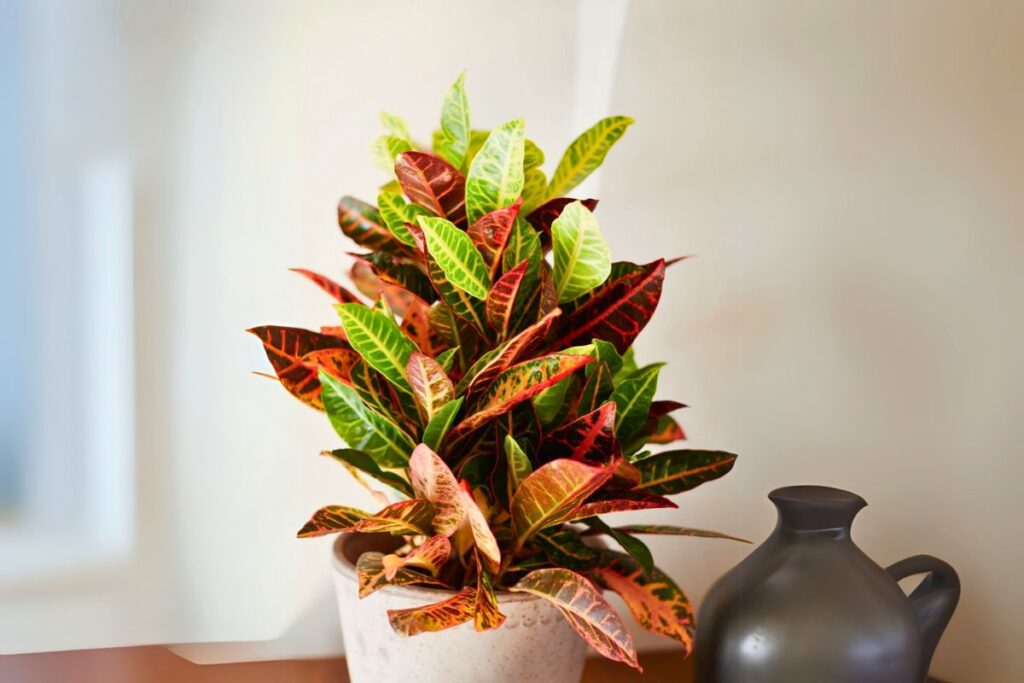Croton plants (Codiaeum variegatum) are known for their stunning, multi-colored foliage and are a favorite among indoor gardeners. These tropical plants are relatively easy to care for and can add a vibrant splash of color to any indoor space. This guide will provide you with all the information you need to grow and maintain a healthy croton plant indoors.

Contents
Understanding Croton Plants
Croton plants are native to tropical regions and are prized for their striking leaves, which come in a variety of colors, including red, yellow, orange, and green. The unique, vibrant patterns on the leaves make croton plants a popular choice for indoor decor. To keep your croton plant healthy and thriving, it’s important to replicate its natural environment as closely as possible.
Choosing the Right Pot and Soil
Selecting the Ideal Pot
When choosing a pot for your croton plant, select one that is slightly larger than the plant’s root ball, with good drainage holes to prevent water from sitting at the bottom. Croton plants do not like to sit in water, so proper drainage is essential to avoid root rot.
Optimal Soil Mix
Croton plants thrive in well-draining soil that retains some moisture. A good mix for croton plants includes equal parts potting soil, peat moss, and perlite. You can also use a commercial potting mix designed for tropical plants. Ensure the soil is loose and well-aerated to allow the roots to breathe.
Lighting and Temperature Requirements
Providing Adequate Light
Croton plants need plenty of light to maintain their vibrant colors. Place your croton in a spot where it will receive bright, indirect light for at least six to eight hours a day. A south- or west-facing window with filtered light is ideal. If your croton isn’t getting enough light, consider using a grow light to supplement natural light.
Maintaining the Right Temperature
Croton plants prefer temperatures between 60-80°F (16-27°C). Avoid placing your croton near drafts, heating vents, or air conditioners, as sudden temperature changes can stress the plant. It’s also important to keep the humidity levels high, as croton plants love a humid environment. You can increase humidity by using a humidifier, placing a tray of water and pebbles near the plant, or misting the leaves regularly.
Watering and Fertilizing
Proper Watering Techniques
Watering croton plants can be a bit tricky, as they don’t like to be too wet or too dry. The key is to keep the soil consistently moist but not soggy. Water your croton when the top inch of soil feels dry to the touch. Use room-temperature water and avoid using water that has been softened, as the salts can harm the plant. It’s also helpful to mist the leaves regularly to maintain humidity.
Feeding Your Croton
Croton plants benefit from regular fertilization during the growing season (spring and summer). Use a balanced, slow-release fertilizer designed for tropical plants every two to three months. You can also use a liquid fertilizer diluted to half strength every four to six weeks. Be careful not to over-fertilize, as this can lead to leaf burn and other issues.
Pruning and Repotting
Pruning for Health and Shape
Regular pruning helps maintain the health and appearance of your croton plant. Remove any dead or yellowing leaves at the base, using clean, sharp scissors or pruning shears. Be gentle when handling the leaves, as croton plants are sensitive to damage. Avoid cutting healthy, green leaves, as this can stress the plant.
When and How to Repot
Croton plants generally need to be repotted every two to three years. Repot your croton in the spring, just before the growing season begins. Choose a pot that is one size larger than the current pot and refresh the soil mix. Be gentle with the roots, and water the plant thoroughly after repotting.
Common Pests and Problems
Identifying and Treating Pests
Indoor croton plants can be susceptible to pests like spider mites, mealybugs, and scale insects. Regularly inspect your plant for any signs of pests, such as yellowing leaves, sticky residue, or webbing. If you notice any pests, treat your croton with insecticidal soap or neem oil, following the instructions on the label.
Troubleshooting Common Issues
Croton plants can be sensitive to changes in their environment, and you may encounter some common problems. Here are a few tips for troubleshooting:
- Yellowing Leaves: This can be caused by overwatering, underwatering, or a nutrient deficiency. Adjust your watering schedule and consider adding a fertilizer.
- Leaf Drop: Croton plants may drop their leaves if they experience sudden temperature changes or lack of humidity. Ensure consistent temperatures and maintain high humidity levels.
- Poor Coloration: Insufficient light or nutrients can lead to dull leaf colors. Make sure your croton is getting enough light and consider fertilizing regularly.
Enjoying Your Indoor Croton
With the right care and attention, your indoor croton plant will reward you with vibrant, colorful foliage that brings a tropical touch to your home. Remember to be patient, as croton plants can be slow to adjust to new environments. By following the tips in this guide, you’ll be well on your way to growing a healthy, happy croton plant indoors.
